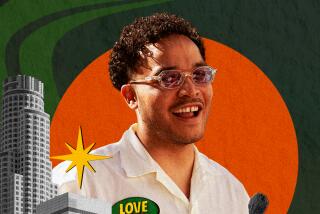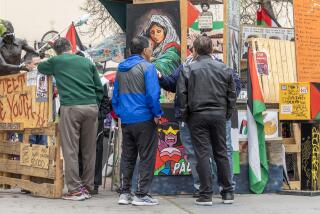Kid Frost Raps to La Raza : Critics denounce the gang references, but the rapper says his music is a reflection of Chicano culture in East L.A.
- Share via
Politics and the arts have always been intertwined in the Chicano movement--El Movimiento. Cesar Chavez’s efforts beginning in the mid-’60s in Central California to unionize farm workers were dramatized by Luis Valdez’s Teatro Campesino--a company that was founded in 1965 and inspired countless Chicano theater groups, which used the stage to explore other political issues, including the Vietnam War, job discrimination and immigration policies. The political awakening of La Raza--”The Race”--was also played out against the backdrop of murals in cities across America. But, since those fiery beginnings, social gains have led to increased assimilation and somewhat cooled the fervor of the Chicano spirit. In turn, the number of Chicano theater groups has diminished and Chicano art was homogenized when it entered the mainstream commercial art world. Here in Los Angeles, scene of early ‘70s protests and boycotts, an upcoming theater production and a retrospective exhibition recall the spirit of La Raza and help cast some perspective on the evolution of Chicano politics. (A contemporary manifestation of Chicano awareness is the rap music of Kid Frost. Despite his controversial use of gang imagery, the East L.A. rapper is stirring pride among the younger generation with his hit single “La Raza.” Page 8.)
Kid Frost, whose stark “La Raza” single is the first national expression of Latino rap social consciousness, didn’t want to meet for an interview in a restaurant or a record company office.
Frost--a squat, muscular man with a tattoo of a pit bull on his right forearm and one of a panther on the left--wanted to meet beneath the bridge at 4th and Lorena streets in East Los Angeles.
This is Chicano Gang Central, a graffiti-dominated concrete landscape that was used in the movie “Colors” as the site of violent clashes. Frost, 28, chose to meet here because he thought it would help shed light on the stark, sometimes brutal imagery in his raps.
“All you see is WF , WF , WF ,” Frost said, pointing to the graffiti marking the territory as that of the White Fence, a gang that has been part of the Chicano community for three generations.
“And see there . . . it says ‘Blood Killer,’ ” he said, showing where a WF had been crossed out and superseded by marks associated with what he described as a black gang.
Frost, whose real name is Arthur Molina Jr., is making his own mark on the heretofore largely black rap world with “La Raza,” a defiant, bilingual statement of Chicano pride from his debut album, “Hispanic Causing Panic.” The song’s topic is his obsession, as manifested in his attire this hot summer afternoon: His black pants, bandanna and “L.A.” cap eschewed affiliation to any specific gang, but identified him as a proud cholo .
“I made ‘La Raza’ for the Mexicans,” he said of the song whose title means “The Race.” “That was my coming-out song . . . describing who I am and where I live. It was a rap version of ‘Colors.’ ”
In the song, Frost said, “It’s me going into the mind of a cholo .” It’s a tense cruise around East L.A. with a young “Aztec warrior” who keeps his gun loaded and threatens to use his “Mafioso” connections against anyone who crosses him. Though brutal, the song makes it clear that the message is for, by and of Chicanos:
I stand alone ese like Al Capone
Ese controla todo so don’t ever try to sweat me
Some of you don’t know what’s happening que pasa
It’s not for you anyway, ‘cause this is for the Raza.
That the message has been taken to heart was demonstrated when two teen-age Chicanos walking by recognized Frost while he posed for photos. Excitedly, they spoke of him as a new hero and of “La Raza” as a long-awaited breakthrough for Chicano culture.
“(The song is) about what Hispanic people are all about,” said German Corda, 17.
Before Kid Frost, said his friend Everardo Stemplesca, 16, “Los Lobos was it” as far as East L.A.-identified pop music was concerned.
But, while Corda and Stemplesca were eager to shake Frost’s hand and tell him to keep on with his message, others in the community, such as Gerard Meraz, a 20-year-old Los Angeles City College student, want to take him to task for it.
After seeing the video of “La Raza” on MTV, Meraz called The Times’ bilingual Nuestro Tiempo publication asking that a story be written about what he believes to be negative stereotypes that are furthered by the song. Meraz is particularly concerned about the video, which consists of scenes in East L.A.
“All they do is hang out and drive around,” Meraz said of the people in the video. “People who probably haven’t met a real Hispanic will think this must be true if one of their own people is presenting that like this.”
But, responded Frost, that’s the point: It is true.
“The truth hurts them bad,” he said, snapping back at his critics. “Chicanos have been doing that (hanging out and cruising) since back in the days of the vatos in the ‘40s. (Meraz) is going to college and that’s good, but what about the ones that don’t and are stuck in the barrio? . . . What do you want them to be doing in the video? In the library?”
If some within the Chicano community are uncomfortable with “La Raza,” it goes without saying that some outside that world would be too. The violent imagery in “La Raza” met with enough resistance from radio programmers that, at Virgin Records’ suggestion, Frost changed some of the lyrics for a “Gringo mix” version.
“We encountered some negative comments about the track,” said Virgin product manager Diana Freed. “People were not really understanding what Kid Frost is about. If you look at the actual lyrics, it’s a very anti-violence song, but taken on a superficial level, people are shocked. His lyrics are going to be hard and confrontational. . . . It’s a very Latin machismo stance that he’s got, but that’s who he is.”
Even some in the Chicano community who are uncomfortable with the images say it does speak of a part of the community that can be traced back to the pachucos of the ‘40s.
“We may not like it and think it doesn’t reflect on the entire community, and it does not,” said Dr. Raul Ruiz, Chicano Studies professor at Cal State Northridge. “But there’s no work and employment and educational opportunities (for many young Chicanos), so what do you do?
“You hang out and sometimes that may not look like a positive activity. . . . Sometimes all (young Chicanos) have is their car and their friends, and inevitably sometimes this leads to problems.”
Miguel Delgado, a director, choreographer and actor who oversaw the recent Chicano Composers Music Awards Festival for La Plaza de la Raza, concurs. “There are certain things (Kid Frost) uses that in terms of mainstream Chicanos are offensive because we spent all our lives to become middle Americans. . . .
“But it’s a sobering effect for people who understand what’s going on. We’ve been censored and denied that we even founded this part of the country. . . . What he’s saying is empowering himself. It’s very reflective of how the minorities feel. You have to go back and say, ‘Hey, power for la Raza .’ ”
Frost says he neither endorses nor condones violence and has been active with anti-gang and anti-drug programs. In the song “Come Together,” he addresses the issue:
Is that the way you want to go out?
For the name of a street,
Getting your damn brains blown out?
But he makes no apologies for the images he uses.
“A lot of people want us to hide our culture, but what about the thousands of kids not given a chance to go to college?” he said. “ ‘Hispanic Causing Panic’ is for all kinds of Chicanos. Don’t blame me for a problem that’s been plaguing us since before 1950, before I was even born.”
Though he was born in Los Angeles, Kid Frost grew up outside of the East L.A. Chicano culture: His father was a career Army man and his family lived on and near bases around the United States, as well as in Guam and West Germany.
While he spent each summer with his grandmother in East L.A. (“My dad wanted to keep me in tune with Hispanic culture”), Frost says that he didn’t see the dark side of that world until his late teens.
“When my dad retired, I was 16 and suddenly put in this environment,” he said. “My parents didn’t clue me in on what was going down on the streets. So when I left the pad at 18 I unfortunately got caught up in the violence of the City of Angels--there aren’t too many angels. It’s a city under siege now.”
Frost refused to comment specifically about what gang he was involved with or its activities, but said he grew uncomfortable as the violence grew more serious. “When it was just fists and boxing I liked it,” he said, noting that he had boxed as a teen in the Police Athletic League. “But when it got crazy with guns, I got out.”
A turning point came for him when he first heard the seminal Sugarhill Gang rap single “Rapper’s Delight.”
“I’d always been doing poetry, but stuff that was crazy for girls,” he said. He began adapting his talent to fit the rap format, and in 1982 was inspired by “The Message,” the socially conscious rap breakthrough by New York’s Grandmaster Flash & the Furious Five. “That was my thing to get straight into rap,” he said.
Soon Frost hooked up with the group DJ Tropical, performing in East L.A. and the San Gabriel Valley.
“They let me do a show, and soon I started doing three or four house parties a night,” he said.
Frost was heard by prominent L.A. rapper Ice-T, who made him part of his Rhyme Syndicate posse. Ice-T’s influence is quite evident in Frost’s even-toned, matter-of-fact delivery.
“He heard me rap and five minutes later he yanked me on stage,” he said. “It was a USC frat party, all black. They gave me respect.”
With Ice-T’s patronage, Frost began getting gigs at more L.A. clubs and became a regular on the “Saturday Night Party Mixes” show on KJLH-FM (102.3). As a rare Latino rapper, Frost also caught the attention of Low Rider magazine, which sent him on a tour performing at events and clubs around the United States.
Now he’s using the status gained from being on a major record label to promote rap in the community through his Latin Alliance. The organization consists of 10 rappers from places as diverse as Nicaragua, Spain and the Bronx as well as Los Angeles.
“We’re planning to get all the dialects of Spanish on one album,” he said.
Frost has already toured Mexico and Latino centers of the United States. Now he’s ready to go places where his subject matter is less familiar.
“I’m going to be going to England,” he said. “Show them a culture they haven’t seen.”
But his primary focus remains on East L.A., where he sees himself as the cutting edge of a musical tradition. “Los Lobos is pals with my uncle,” he said. “Tierra, El Chicano, they all know Kid Frost. But rap music ! It’s the music of my streets.”
More to Read
The biggest entertainment stories
Get our big stories about Hollywood, film, television, music, arts, culture and more right in your inbox as soon as they publish.
You may occasionally receive promotional content from the Los Angeles Times.










